Decarbonizing the Global Economy—Investigating the Role of Carbon Emission Inertia Using the Integrated Assessment Model MIND
Abstract
:1. Introduction
2. Climate Policy
“This [the agreement in Paris, Conference of the Parties, COP 21, note of the authors] should enable all countries to follow a low carbon and resilient development pathway in line with the global goal to hold the increase in global average temperature below 2 °C. Mindful of this goal and considering the latest IPCC [Intergovernmental Panel on Climate Change, note of the authors] results, we emphasize that deep cuts in global greenhouse gas emissions are required with a decarbonisation of the global economy over the course of this century”
“[Parties [collectively][cooperatively] aim to reach the global temperature goal referred to in Article 2 through:
(a) [A peaking of global greenhouse gas emissions as soon as possible[, recognizing that peaking requires deeper cuts of emissions of developed countries and will be longer for developing countries]]
(b) [Rapid reductions thereafter [in accordance with best available science] to at least a X [-Y] per cent reduction in global [greenhouse gas emissions][CO[e]] compared to 20XX levels by 2050]];
(c) [Achieving zero global GHG emissions by 2060–2080]
(d) [A long-term low emissions transformation] [toward [climate neutrality] [decarbonization] [over the course of this century] [as soon as possible after mid-century];
(e) [Equitable distribution of a global carbon budget based on historical responsibilities and [climate] justice] [on the basis of equity and common but differentiated responsibilities and respective capabilities] [in the context of sustainable development and eradication of poverty][while ensuring that food security, production and distribution is not threatened][informed by the best available science]…”.
“… holding the increase in the global average temperature to well below 2 °C above pre-industrial levels and to pursue efforts to limit the temperature increase to 1.5 °C above pre-industrial levels, recognizing that this would significantly reduce the risks and impacts of climate change.”
“As nationally determined contributions to the global response to climate change, all Parties are to undertake and communicate ambitious efforts as defined in Articles 4, 7, 9, 10, 11 and 13 with the view to achieving the purpose of this Agreement as set out in Article 2. The efforts of all Parties will represent a progression over time while recognizing the need to support developing country Parties for the effective implementation of this Agreement”.
“In order to achieve the long-term temperature goal set out in Article 2, Parties aim to reach global peaking of greenhouse gas emissions as soon as possible, recognizing that peaking will take longer for developing country Parties, and to undertake rapid reductions thereafter in accordance with best available science, so as to achieve a balance between anthropogenic emissions by sources and removals by sinks of greenhouse gases in the second half of this century, on the basis of equity, and in the context of sustainable development and efforts to eradicate poverty …”.
3. Methodology
3.1. Model
3.2. Climate Policy Scenarios
4. Simulation Results and Discussion
Analogously, REN 21 (2015) estimates of the total new investment during 2014 in renewable power and fuels (not including renewable heating and cooling) amount to at least USD 301 billion. The World Bank (The World Bank 2015, 2016) provides gross domestic product (GDP) at a global scale so that we can calculate the share of investment in renewable energy production, that is, 0.448% in 2015 and 0.388% in 2014. OECD/IEA and IRENA (2017) estimate that “G20 countries accounted for around 85% of the USD 288 billion of global renewables investment in 2015” (p. 24).“Global new investment in renewable power and fuels climbed to a record USD 285.9 billion in 2015 (not including hydropower projects > 50 MW). This represents a rise of 5% compared to 2014 (USD 270.2 billion) and exceeds the previous record (USD 278.5 billion) achieved in 2011. Including investments in hydropower projects larger than 50 MW, total new investment during 2015 in renewable power and fuels (not including renewable heating and cooling) was at least USD 328.9 billion. […] Solar power was again the leading sector by far in terms of money committed during 2015, accounting for USD 161 billion (up 12% over 2014), or more than 56% of total new investment in renewable power and fuels. Wind power followed with USD 109.6 billion, or 38.3% of the total (up 4%). All technologies except solar and wind power saw investment decline relative to 2014: investment in biomass and waste-to-energy fell by 42% to USD 6 billion, small-scale hydropower fell by 29% to USD 3.9 billion, biofuels fell by 35% to USD 3.1 billion, geothermal energy fell by 23% to USD 2 billion, and ocean energy fell by 42% to USD 215 million.”
5. Conclusions and Future Research
Author Contributions
Funding
Data Availability Statement
Acknowledgments
Conflicts of Interest
Appendix A
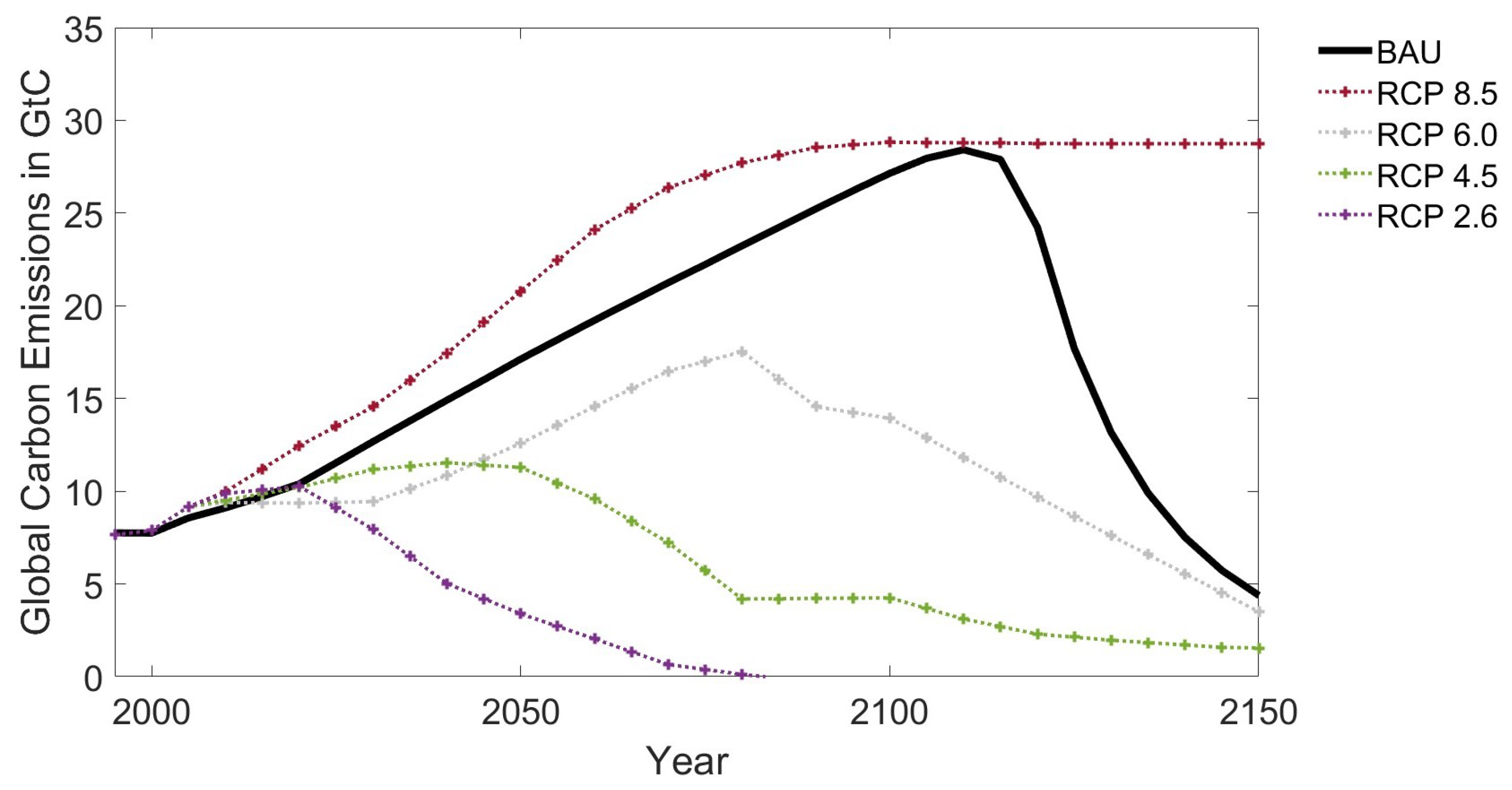
| 1 | See Khabbazan (2022a); Neubersch et al. (2014) for a review of the differences between various decision-making frameworks, such as Cost–Benefit Analysis (CBA), Cost-Effectiveness Analysis (CEA), Chance-Constrained Programming (CCP) (as the probabilistic version of CEA), and Cost–Risk Analysis (CRA). |
| 2 | After countries ratified their Paris Pledges, INDC changed to NDC (National Determined Contributions). However, some (relatively major emitting) countries have still not ratified their Paris Pledges (Khabbazan and von Hirschhausen 2021), probably due to the significant costs of achieving their INDCs. Therefore, here we use the expression INDC to account for the INDCs by the non-ratifying countries too. |
| 3 | The special report on 1.5 °C (IPCC 2018) can be found here: https://www.ipcc.ch/sr15/ (last Accessed 18 April 2022). The special report estimates that human activities have induced around 1.0 °C of global warming above pre-industrial levels, and if it persists in rising at the present rate, it is likely to reach 1.5 °C between 2030 and 2052. |
| 4 | In 2019, CAN reported that the world is currently on a 3 °C pathway: https://climatenetwork.org/resource/can-position-energy-ambition-in-ndcs-june-2019/ (last accessed 18 April 2022). |
| 5 | Since we intend to study the decarbonization of the global economy only through the mitigation scenarios, we do not employ Carbon Capturing and Storage (CCS), Bio-Energy Carbon Capturing and Storage (BECCS), or Solar Geo-Engineering (SGE) technologies. An interested reader is encouraged to see Khabbazan et al. (2021); Mintening et al. (2017); Roshan et al. (2021) for recent technologies in the model MIND. |
| 6 | Rogelj et al. (2016, p. 637) consider INDCs and find decision-makers become increasingly aware “that measures to reduce GHG emissions have multiple socio-economic benefits”. However, they investigate CO equivalents, e.g., methane and nitrous oxide, while MIND works with anthropogenic global carbon emissions due to fossil fuels and the change of land use. |
| 7 | While many countries are constantly updating their long-term promises, the overall promises for 2030 do not seem to be on the path to meeting the temperature targets (IPCC 2018; Khabbazan and von Hirschhausen 2021). While we admit that the analysis in this work can be updated accordingly, the generality of our arguments and results hold valid and can be used as it is. |
| 8 | MIND has implemented a constraint on CEI, i.e., how much the global carbon emissions are allowed to change per time step in Equation (5). Since the setup only allows specific percentage changes from each time step to the other, it is mathematically impossible to reach precisely 0 GtC. Therefore, we allow for 0.05 GtC. |
| 9 | Note that some simulations are not feasible, so the results for such simulations are not determined. |
| 10 | Note that estimates are based on different reference points, i.e., relative to 1986–2005 (Stocker et al. (2013), Fig. TS.14, p. 87) and 1900 (MIND). |
| 11 | Schaeffer et al. (2015) find that RCP 2.6 corresponds to 1.6 °C global warming and, hence, transgresses the 1.5 °C climate target. |
References
- Afonso, Tiago L., António C. Marques, and José A. Fuinhas. 2017. Strategies to make renewable energy sources compatible with economic growth. Energy Strategy Reviews 18: 121–26. [Google Scholar] [CrossRef]
- Anthoff, David, and Richard S. J. Tol. 2009. The Impact of Climate Change on the Balanced Growth Equivalent: An Application to FUND. Environmental and Resource Economics 43: 351–67. [Google Scholar] [CrossRef]
- Bartlett, Rachel E., Massimo A. Bollasina, Ben B. B. Booth, Nick J. Dunstone, Franco Marenco, Gabriele Messori, and Dan J. Bernie. 2017. Do differences in future sulfate emission pathways matter for near-term climate? A case study for the Asian monsoon. Climate Dynamics, in press. [Google Scholar]
- Bauer, Niclas Alexandre. 2005. Carbon Capturing and Sequestration—An Option to Buy Time? Doctoral dissertation, Universität Potsdam, Potsdam, Germany. [Google Scholar]
- Bauer, Nico, Ottmar Edenhofer, Hermann Held, and Elmar Kriegler. 2004. Uncertainty of the Role of Carbon Capturing and Sequestration within Climate Change Mitigation Strategies. Paper presented at 7th International Conference on Greenhouse Gas Control Technologies, Vancouver, BC, Canada, September 5; Edited by E. S. Rubin, D. W. Keith and C. F. Gilboy. Volume 1: Peer-Reviewed Paper and Plenary Presentations. Cheltenham: IEA Greenhouse Gas Programme. [Google Scholar]
- Boden, Tom, Gregg Marland, and Robert Andres. 2017. Global, Regional, and National Fossil-Fuel CO2 Emissions. Oak Ridge: Carbon Dioxide Information Analysis Center, Oak Ridge National Laboratory, U.S. Department of Energy. [Google Scholar]
- Bosetti, Valentina, Carlo Carraro, Marzio Galeotti, Emanuele Massetti, and Massimo Tavoni. 2006. WITCH—A World Induced Technical Change Hybrid Model. In University Ca’ Foscari of Venice Economic Research Paper No. 46/06. Rochester: SSRN. [Google Scholar]
- Chalmers N., Eleanor J. Highwood, E. Hawkins, R. Sutton, and L.J. Wilcox. 2012. Aerosol contribution to the rapid warming of near-term climate under RCP 2.6. Geophysical Research Letters 39: L18709. [Google Scholar] [CrossRef] [Green Version]
- Clarke, Leon, Kejun Jiang, Keigo Akimoto, Mustafa Babiker, Geoffrey Blanford, Karen Fisher-Vanden, Jean-Charles Hourcade, Volker Krey, Elmar Kriegler, Andreas Loeschel, and et al. 2014. Working Group III Contribution to the IPCC 5th Assessment Report “Climate Change 2014: Mitigation of Climate Change”. Chapter 6: Assessing Transformation Pathways. Technical Report. Richland: Pacific Northwest National Lab. (PNNL). [Google Scholar]
- Climate Action Network (CAN) International. 2016. CAN Letter: IPCC Special Report on the Impacts of Global Warming of 1.5 °C. February. Available online: https://climatenetwork.org/resource/can-letter-ipcc-special-report-on-the-impacts-of-global-warming-of-1-5oc-february-2016/ (accessed on 18 April 2022).
- Climate Action Tracker. 2017. Global Temperatures. Available online: https://climateactiontracker.org/global/temperatures/ (accessed on 19 April 2022).
- Edenhofer, Ottmar, Nico Bauer, and Elmar Kriegler. 2005. The impact of technological change on climate protection and welfare: Insights from the model mind. Ecological Economics 54: 277–92. [Google Scholar] [CrossRef]
- Fawcett, Allen A., Gokul Iyer, Leon Clarke, James A. Edmonds, Nathan E. Hultman, Haewon C. McJeon, Joeri Rogelj, Reed Schuler, Jameel Alsalam, Ghassem R. Asrar, and et al. 2015. Can Paris pledges avert severe climate change? Science 350: 1168–69. [Google Scholar] [CrossRef]
- Hasson, Reviva, Åsa Löfgren, and Martine Visser. 2010. Climate change in a public goods game: Investment decisions in mitigation versus adaptation. Ecological Economics 70: 331–38. [Google Scholar] [CrossRef] [Green Version]
- Heitzig, Jobst, Kai Lessmann, and Yong Zou. 2011. Self-enforcing strategies to deter free-riding in the climate change mitigation game and other repeated public goods games. Proceedings of the National Academy of Sciences the United States of America 108: 15739–744. [Google Scholar] [CrossRef] [Green Version]
- Held, Hermann, Elmar Kriegler, Kai Lessmann, and Ottmar Edenhofer. 2009. Efficient climate policies under technology and climate uncertainty. Energy Economics 31: 50–61. [Google Scholar]
- IPCC (Intergovernmental Panel on Climate Change). 2016. IPCC Sixth Assessment Report (AR6). Available online: https://www.ipcc.ch/assessment-report/ar6/ (accessed on 24 July 2022).
- IPCC (Intergovernmental Panel on Climate Change). 2018. Global Warming of 1.5 °C. Available online: https://www.ipcc.ch/sr15/ (accessed on 18 April 2022).
- Khabbazan, Mohammad M. 2022a. Cost-Risk Analysis Reconsidered—Value of Information on the Climate Sensitivity in the Integrated Assessment Model PRICE. Energies 15: 4096. [Google Scholar] [CrossRef]
- Khabbazan, Mohammad M. 2022b. The EU’s Gain (Loss) from More Emission Trading Flexibility—A CGE Analysis with Parallel Emission Trading Systems. Journal of Open Innovation: Technology, Market, and Complexity 8: 91. [Google Scholar] [CrossRef]
- Khabbazan, Mohammad M., and Christian von Hirschhausen. 2021. The implication of the Paris targets for the Middle East through different cooperation options. Energy Economics 104: 105629. [Google Scholar] [CrossRef]
- Khabbazan, Mohammad M., and Hermann Held. 2019. On the Future Role of the most Parsimonious Climate Module in Integrated Assessment. Earth System Dynamics 10: 135–55. [Google Scholar] [CrossRef] [Green Version]
- Khabbazan, Mohammad M., Marius Stankoweit, Elnaz Roshan, Hauke Schmidt, and Hermann Held. 2021. How can solar geoengineering and mitigation be combined under climate targets? Earth System Dynamics 12: 1529–42. [Google Scholar] [CrossRef]
- Kirtman, B., S. B. Power, J. A. Adedoyin, G. J. Boer, R. Bojariu, I. Camilloni, F. J. Doblas-Reyes, A. M. Fiore, M. Kimoto, G. A. Meehl, and et al. 2013. Near-term climate change: Projections and predictability. In Climate Change 2013: The Physical Science Basis. Contribution of Working Group I to the Fifth Assessment Report of the Intergovernmental Panel on Climate Change. Cambridge: Cambridge University Press, pp. 953–1028. [Google Scholar]
- Kriegler, Elmar, and Thomas Bruckner. 2004. Sensitivity Analysis of Emission Corridors for the 21st Century. Climatic Change 66: 345–87. [Google Scholar] [CrossRef]
- Lamarque, Jean-François, G. Page Kyle, Malte Meinshausen, Keywan Riahi, Steven J. Smith, Detlef P. van Vuuren, Andrew J. Conley, and Francis Vitt. 2011. Global and regional evolution of short-lived radiatively-active gases and aerosols in the representative concentration pathways. Climatic Change 109: 191–212. [Google Scholar] [CrossRef]
- Leaders’ Declaration G7 Summit. 2015. June 7–8. Available online: https://www.consilium.europa.eu/en/meetings/international-summit/2015/06/07-08/ (accessed on 16 April 2022).
- Leaders’ Declaration G7 Summit. 2016. May 26–27. Available online: https://www.consilium.europa.eu/en/press/press-releases/2016/05/27/g7-japan-leaders-declaration/ (accessed on 16 April 2022).
- Leaders’ Declaration G7 Summit. 2017. May 26–27. Available online: https://www.consilium.europa.eu/en/meetings/international-summit/2017/05/26-27/ (accessed on 16 April 2022).
- Leaders’ Declaration G20 Summit. 2017. July 7–8. Available online: https://www.bundesregierung.de/breg-de/aktuelles/g20-summit-2017-leaders-declaration-751184 (accessed on 16 April 2022).
- Leaders’ Declaration G7 Summit. 2018. June 8–9. Available online: http://www.g7.utoronto.ca/summit/2018charlevoix/communique.html (accessed on 18 April 2022).
- Leaders’ Declaration G7 Summit. 2019. August 26. Available online: https://www.elysee.fr/en/g7/2019/08/26/g7-leaders-declaration (accessed on 18 April 2022).
- Leaders’ Declaration G7 Summit. 2021. June 11–13. Available online: https://www.g7uk.org/uks-2021-g7-presidency-helps-the-world-build-back-better/ (accessed on 18 April 2022).
- Leaders’ Declaration G7 Summit. 2022. June 28 (German and English Version). Available online: https://www.g7germany.de/g7-en (accessed on 1 July 2022).
- Li, Chao, Hermann Held, Sascha Hokamp, and Jochem Marotzke. 2020. Optimal temperature overshoot profile found by limiting global sea level rise as a lower-cost climate target. Science Advances 6: eaaw9490. [Google Scholar] [CrossRef] [Green Version]
- Lind, Arne, Eva Rosenberg, Pernille Seljom, Kari Espegren, Audun Fidje, and Karen Lindberg. 2013. Analysis of the EU renewable energy directive by a techno-economic optimisation model. Energy Policy 60: 364–77. [Google Scholar] [CrossRef]
- Lorenz, Alexander, Matthias G. W. Schmidt, Elmar Kriegler, and Hermann Held. 2012. Anticipating climate threshold damages. Environmental Modelling & Assessment 17: 163–75. [Google Scholar]
- Luderer, Gunnar, Valentina Bosetti, Michael Jakob, Marian Leimbach, Jan C. Steckel, Henri Waisman, and Ottmar Edenhofer. 2012. The Economics of Decarbonizing the Energy System—Results and Insights from the RECEIPE Model Intercomperison. Climatic Change 114: 9–37. [Google Scholar] [CrossRef]
- Meinshausen, Malte, Steven J. Smith, Katherine V. Calvin, John S. Daniel, M. L. T. Kainuma, J.-F. Lamarque, K. Matsumoto, S. A. Montzka, S. C. B. Raper, K. Riahi, and et al. 2011. The RCP Greenhouse Gas Concentrations and their Extensions from 1765 to 2300. Climatic Change 109: 213–41. [Google Scholar] [CrossRef] [Green Version]
- Mintenig, Jana, Mohammad M. Khabbazan, and Hermann Held. 2017. The Role of Bioenergy and Carbon Capture and Storage (BECCS) in the Case of Delayed Climate Policy–Insights from Cost-Risk Analysis. Earth System Dynamics Discussions 2017: 1–30. [Google Scholar] [CrossRef]
- Mohammadi, Naimeh, and Mohammad M. Khabbazan. 2022. The Influential Mechanisms of Power Actor Groups on Policy Mix Adoption: Lessons Learned from Feed-In Tariffs in the Renewable Energy Transition in Iran and Germany. Sustainability 14: 3973. [Google Scholar] [CrossRef]
- Neubersch, Delf. 2014. Value of Information under Climate Targets: An Application of Cost-Risk Analysis. Doctoral dissertation, Universität Hamburg, Hamburg, Germany. [Google Scholar]
- Neubersch, Delf, Hermann Held, and Alexander Otto. 2014. Operationalizing climate targets under learning: An application of cost-risk analysis. Climatic Change 126: 305–18. [Google Scholar] [CrossRef] [Green Version]
- Nordhaus, William. 2013. The Climate Casino, Risk, Uncertainty, and Economics for a Warming World. New Haven & London: Yale University Press. [Google Scholar]
- Nordhaus, William. 2014. Estimates of the Social Cost of Carbon: Concepts and Results from the DICE-2013R Model and Alternative Approaches. Journal of the Association of Environmental and Resource Economists 1: 273–312. [Google Scholar] [CrossRef]
- Nordhaus, William, and Paul Sztorc. 2013. DICE2013R: Introduction and User’s Manual. Available online: http://www.econ.yale.edu/~nordhaus/homepage/homepage/documents/DICE_Manual_100413r1.pdf (accessed on 19 April 2022).
- OECD/IEA, and IRENA. 2017. [Executive Summary/Chapter [1/4]] of Perspectives for the Energy Transition—Investment Needs for a Low Carbon Energy System. Available online: https://www.irena.org/publications/2017/Mar/Perspectives-for-the-energy-transition-Investment-needs-for-a-low-carbon-energy-system (accessed on 24 July 2022).
- Petschl-Held, Gerhard, Hans-Joachim Schellnhuber, Thomas Bruckner, Ferenc L. Tóth, and Klaus Hasselmann. 1999. The Tolerable Windows Approach: Theoretical and Methodological Foundations. Climatic Change 41: 303–31. [Google Scholar] [CrossRef]
- REN 21 (Renewable Energy Policy Network for the 21st Century). 2015. Renewables 2015 Global Status Report. Available online: https://www.ren21.net/wp-content/uploads/2019/05/GSR2015_Full-Report_English.pdf (accessed on 24 July 2022).
- REN 21 (Renewable Energy Policy Network for the 21st Century). 2016. Renewables 2016 Global Status Report. Available online: https://www.ren21.net/wp-content/uploads/2019/05/REN21_GSR2016_FullReport_en_11.pdf (accessed on 24 July 2022).
- Rogelj, Joeri, Michel den Elzen, Niklas Höhne, Taryn Fransen, Hanna Fekete, Harald Winkler, Roberto Schaeffer, Fu Sha, Keywan Riahi, and Malte Meinshausen. 2016. Paris Agreement climate proposals need a boost to keep warming well below 2 °C. Nature 534: 631–39. [Google Scholar] [CrossRef] [Green Version]
- Roshan, Elnaz, Mohammad M. Khabbazan, and Hermann Held. 2019. Cost-risk trade-off of mitigation and solar geoengineering: Considering regional disparities under probabilistic climate sensitivity. Environmental and Resource Economics 72: 263–79. [Google Scholar] [CrossRef]
- Roshan, Elnaz, Mohammad M. Khabbazan, and Hermann Held. 2021. A Scheme for Jointly Trading off Costs and Risks of Solar Radiation Management and Mitigation Under Long-Tailed Climate Sensitivity Probability Density Distributions. Environmental Modeling & Assessment 26: 823–36. [Google Scholar]
- Roth, Robert, Delf Neubersch, and Hermann Held. 2015. Evaluating Delayed Climate Policy by Cost-Risk Analysis. Paper presented at the 21st Annual Conference of the European Association of Environmental and Resource Economists, Helsinki, Finland, June 24–27. [Google Scholar]
- Schaeffer Michiel, Joeri Rogelj, Niklas Roming, Fabio Sferra, Bill Hare, and Olivia Serdeczny. 2015. Feasibility of Limiting Warming to 1.5 and 2 °C. Climate Analytics. Available online: https://climateanalytics.org/media/feasibility_1p5_2.pdf (accessed on 24 July 2022).
- Stein, Lukas, Mohammad M. Khabbazan, and Hermann Held. 2020. Replacing Temperature Targets by Subsidiary Targets: How Accurate Are They?: Overshooting vs. Economic Losses. Available online: https://www.wiso.uni-hamburg.de/forschung/forschungslabor/working-papers/pdfs-wp/wp57.pdf (accessed on 18 April 2022).
- Stern, Nicholas. 2007. The Economics of Climate Change. London: HM Treasury. [Google Scholar]
- Stocker, Thomas F., Dahe Qin, Gian-Kasper Plattner, L. V. Alexander, Simon K. Allen, N. L. Bindoff, F.-M. Bréon, J. A. Church, U. Cubasch, S. Emori, and et al. 2013. Technical Summary. In Climate Change 2013: The Physical Science Basis. Contribution of Working Group I to the Fifth Assessment Report of the Intergovernmental Panel on Climate Change. Cambridge and New York: Cambridge University Press. [Google Scholar]
- Tavoni, Alessandro, Astrid Dannenberg, Giorgos Kallis, and Andreas Löschel. 2009. Inequality, communication, and the avoidance of disastrous climate change in a public goods game. Proceedings of the National Academy of Sciences the United States of America 108: 1185–89. [Google Scholar] [CrossRef] [Green Version]
- The Copenhagen Diagnosis. 2009. Updating the World on the Latest Climate Science. Sydney: The University of New South Wales Climate Change Research Centre (CCRC). [Google Scholar]
- The World Bank. 2015. World Development Indicators Database. Available online: https://databank.worldbank.org/source/world-development-indicators (accessed on 24 July 2022).
- The World Bank. 2016. World Development Indicators Database. Available online: https://databank.worldbank.org/source/world-development-indicators (accessed on 24 July 2022).
- UNFCCC. 2022. Integrated Assessment Models (IAMs) and Energy Environment Economy e3 Models. Available online: https://unfccc.int/topics/mitigation/workstreams/response-measures/integrated-assessment-models-iams-and-energy-environment-economy-e3-models#eq-20 (accessed on 26 May 2022).
- UNFCCC (United Nations Framework Convention on Climate Change). 2010. Decisions-Cancun Climate Change Conference-November 2010. Available online: https://unfccc.int/process-and-meetings/conferences/past-conferences/cancun-climate-change-conference-november-2010/decisions-cancun-climate-change-conference-november-2010 (accessed on 18 April 2022).
- UNFCCC (United Nations Framework Convention on Climate Change). 2015a. Adoption of the Paris Agreement (COP 21). Available online: https://unfccc.int/resource/docs/2015/cop21/eng/l09r01.pdf (accessed on 24 July 2022).
- UNFCCC (United Nations Framework Convention on Climate Change). 2015b. Draft Paris Agreement. Available online: https://unfccc.int/files/bodies/awg/application/pdf/draft_paris_agreement_5dec15.pdf (accessed on 24 July 2022).
- UNFCCC (United Nations Framework Convention on Climate Change). 2016. Decisions adopted by the Conference of the Parties (COP 22). Available online: https://unfccc.int/resource/docs/2016/cop22/eng/10a02.pdf (accessed on 24 July 2022).
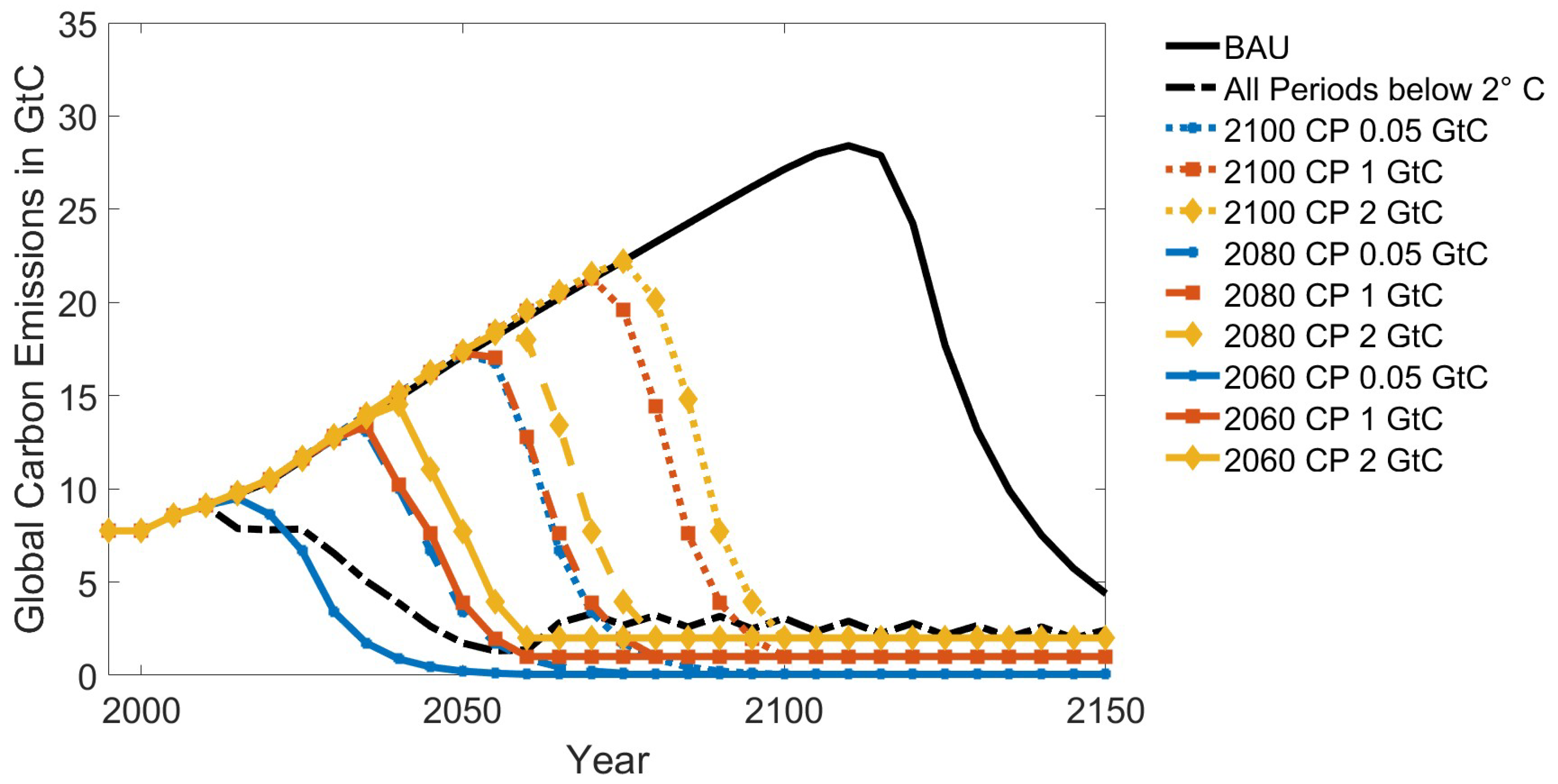

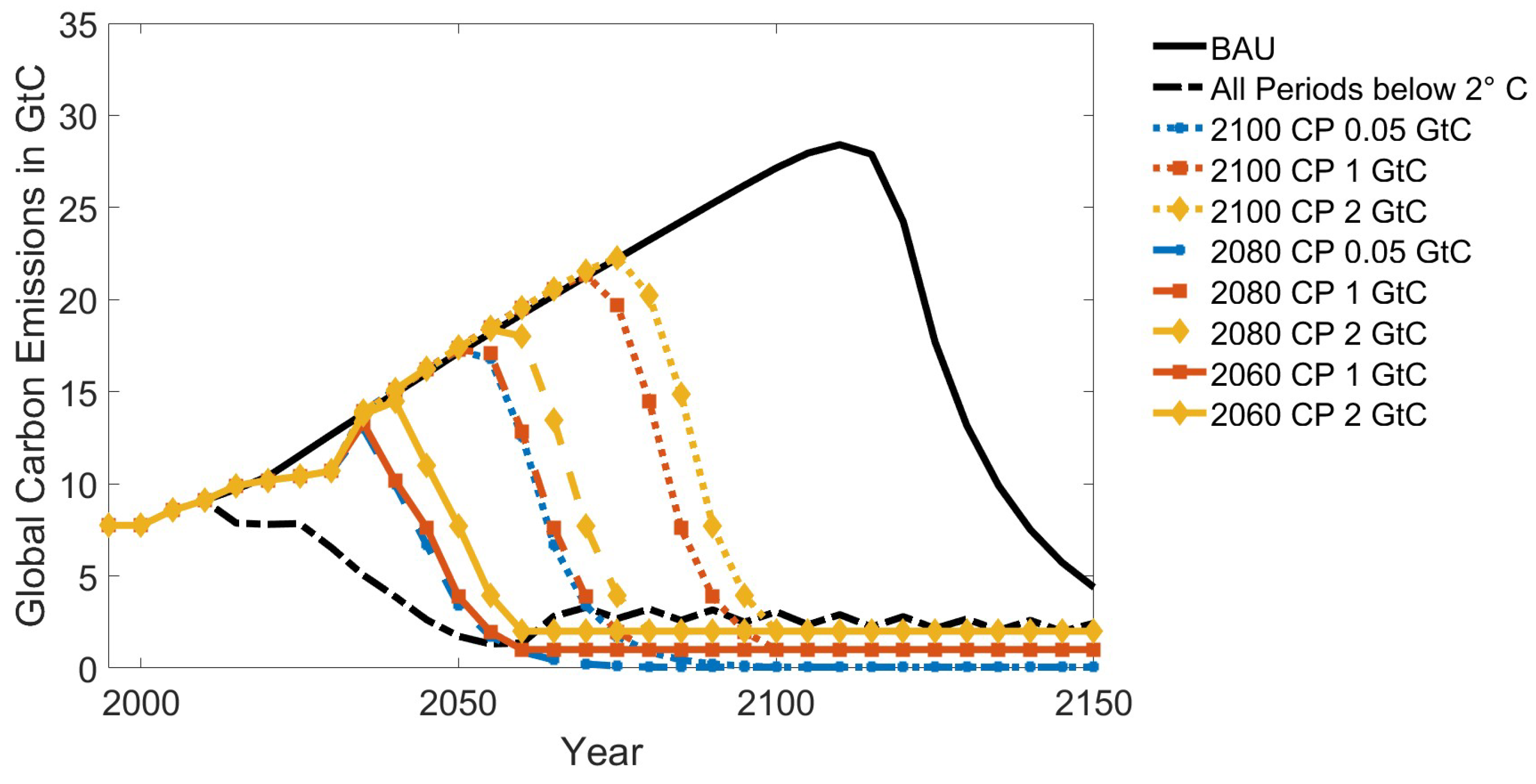
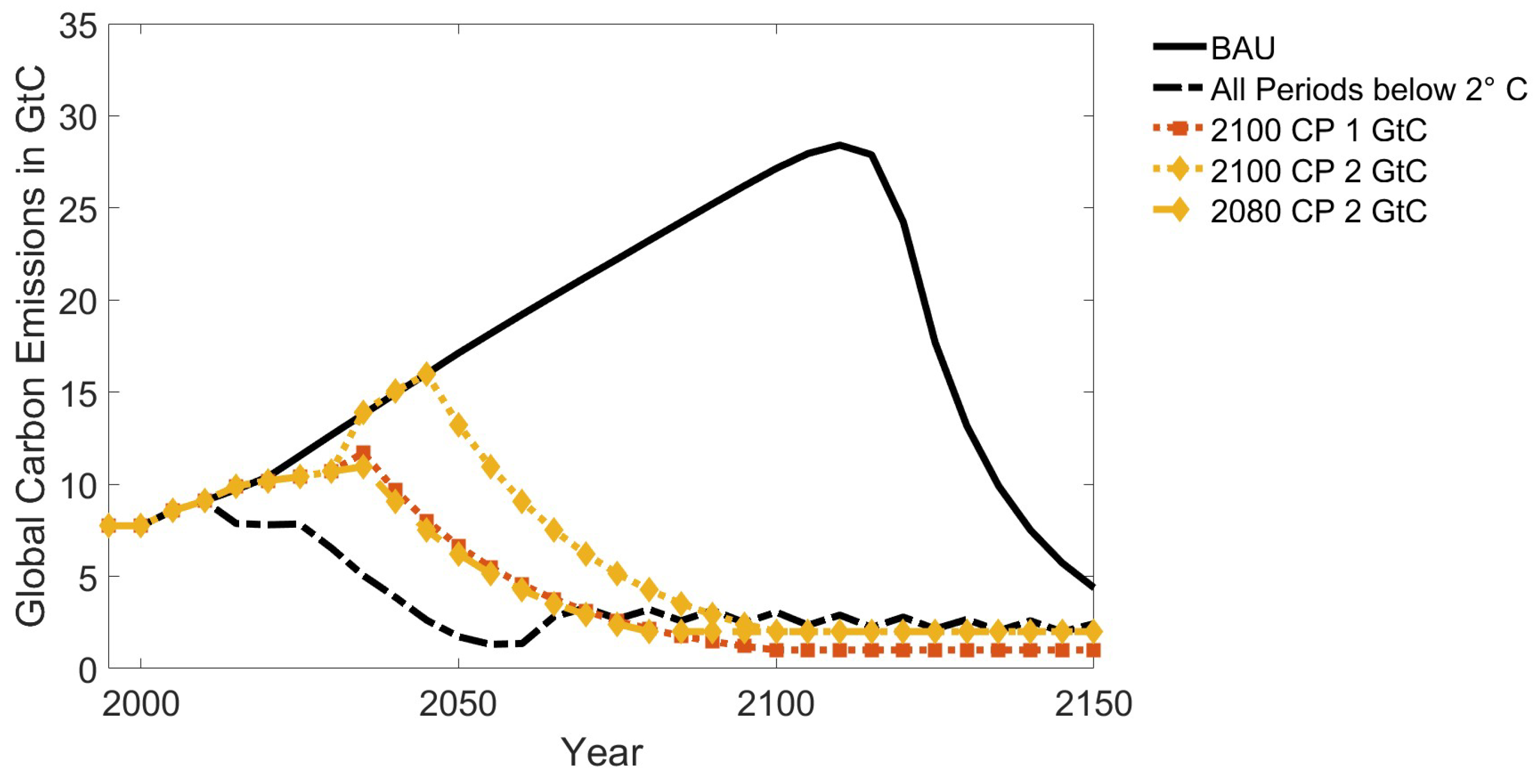
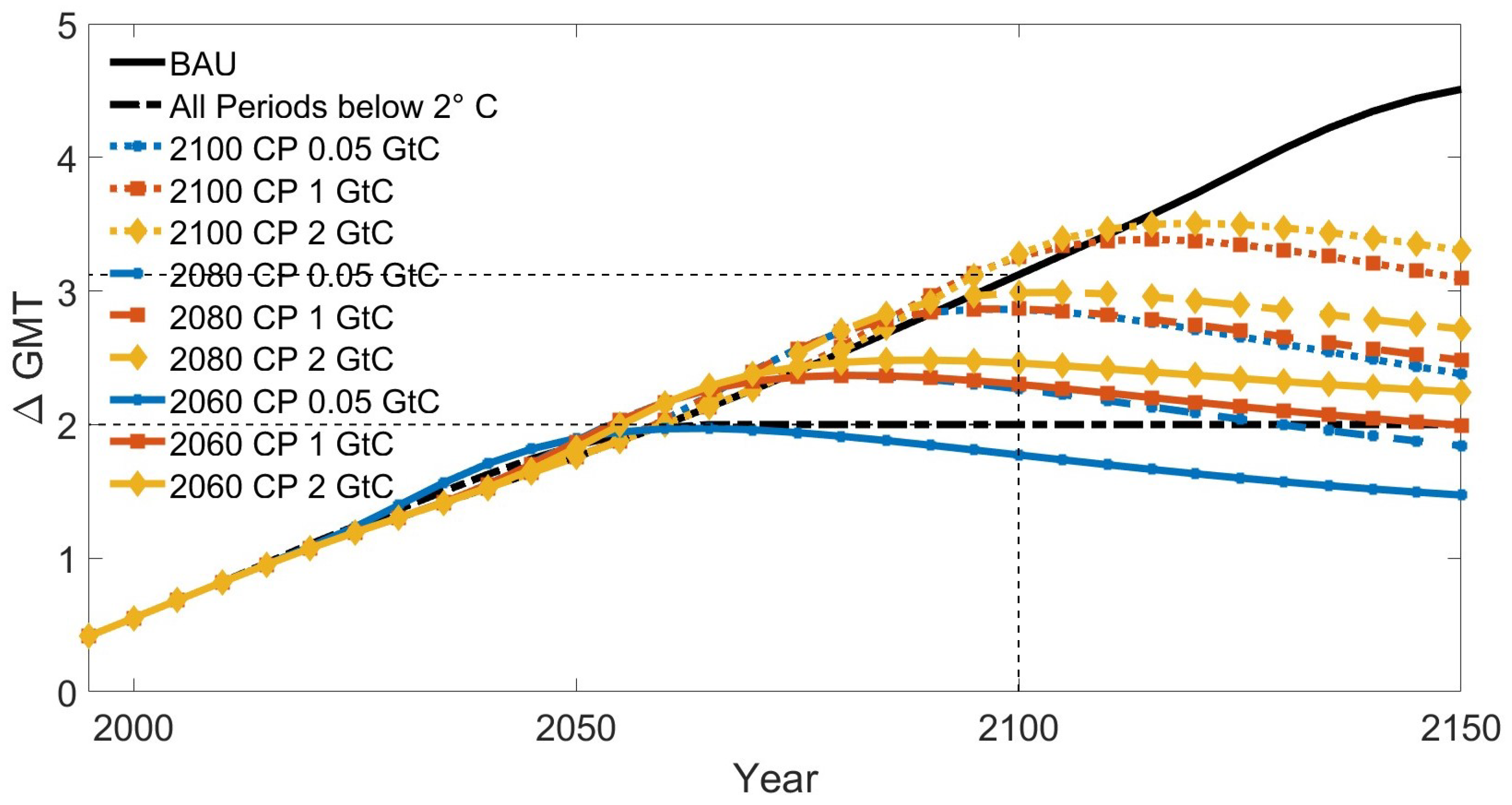
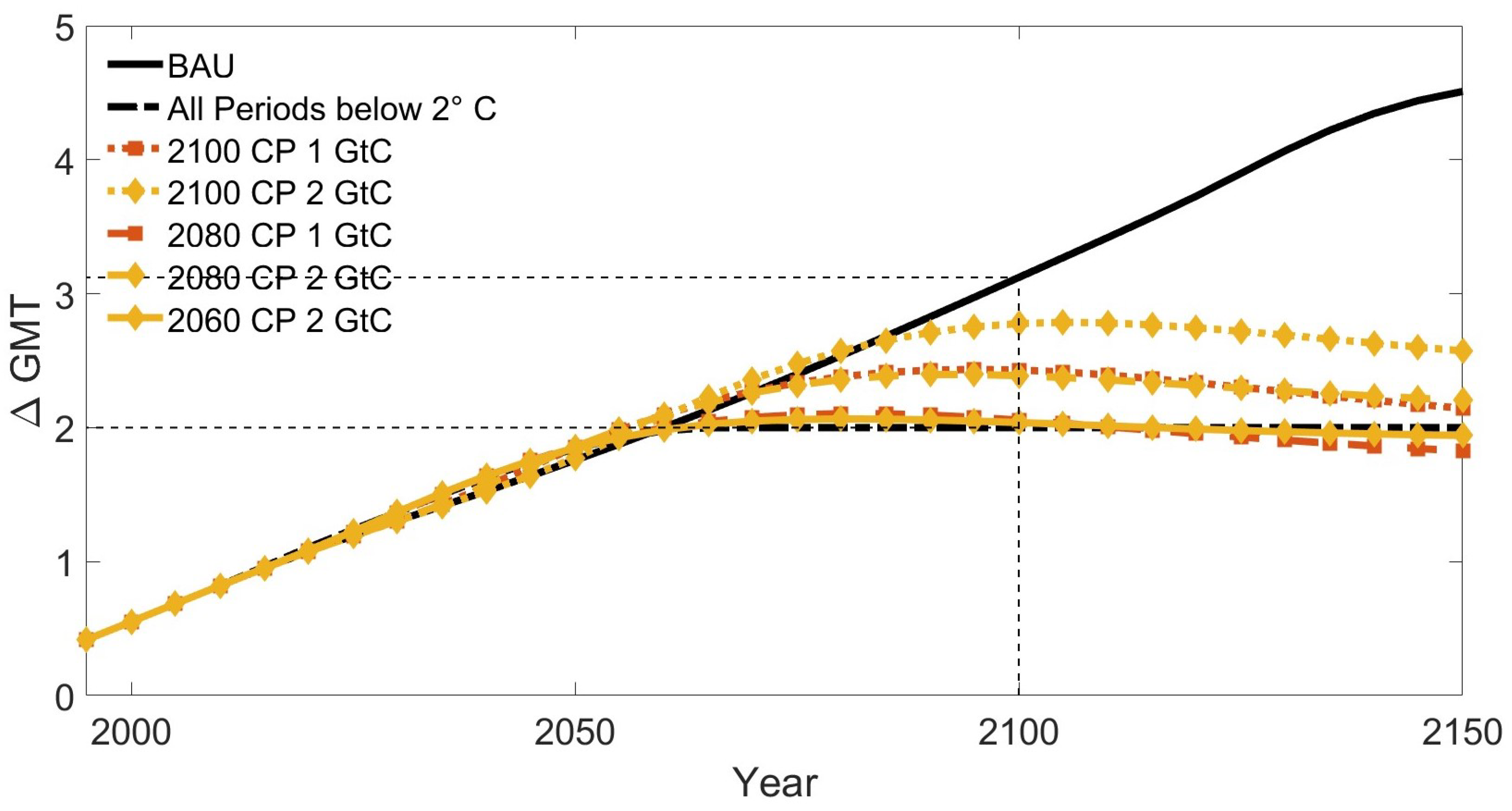

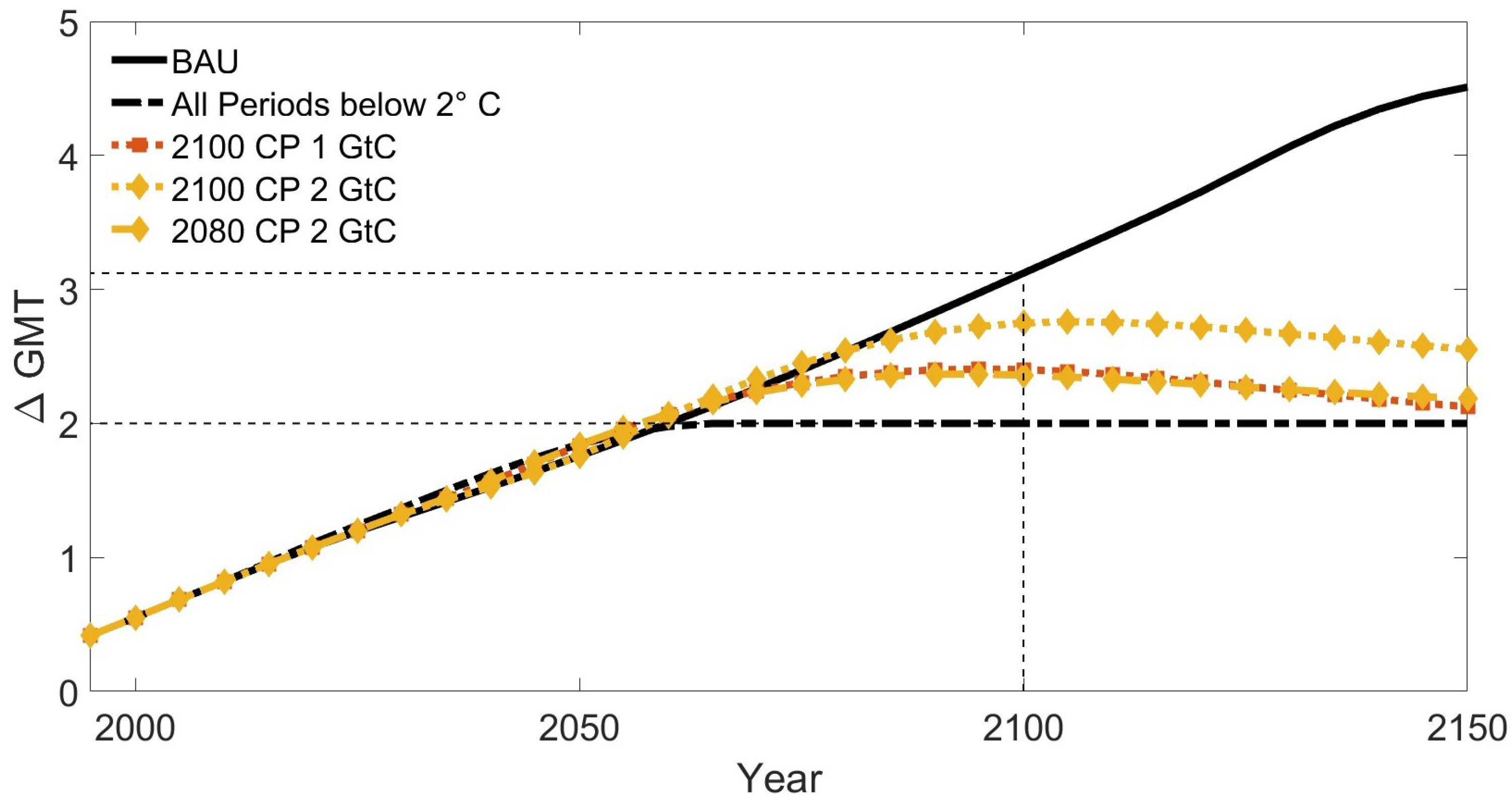
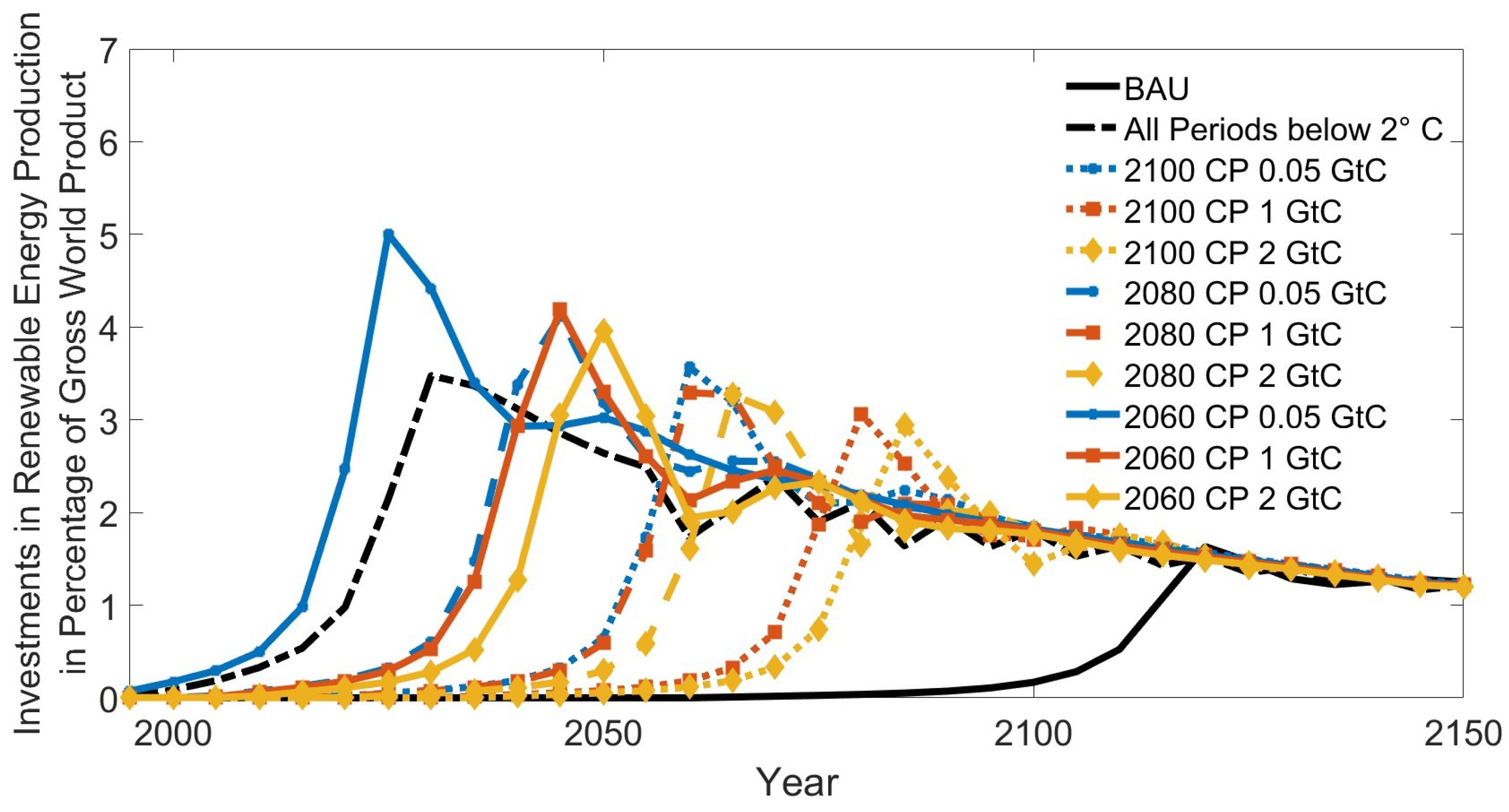
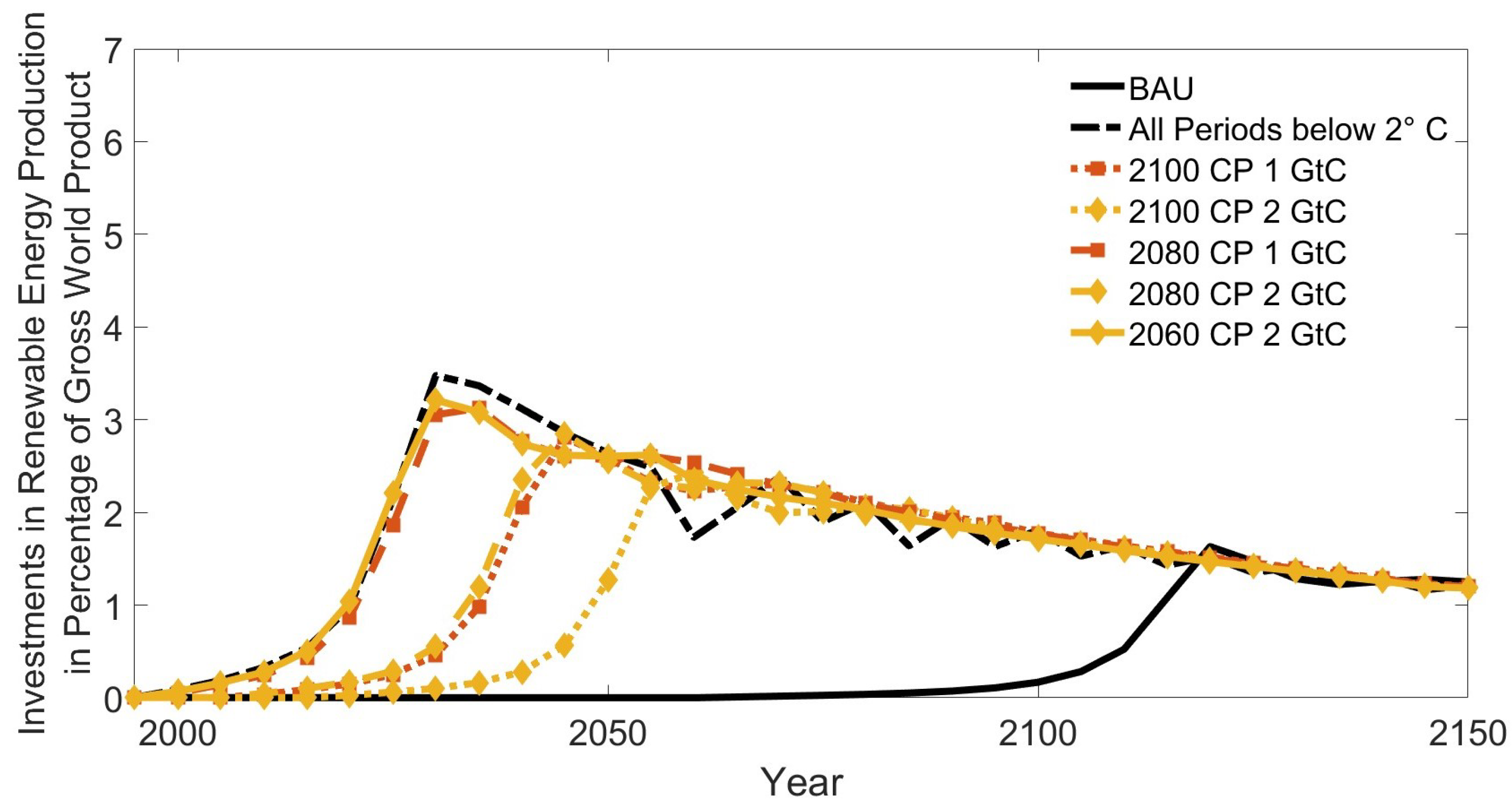
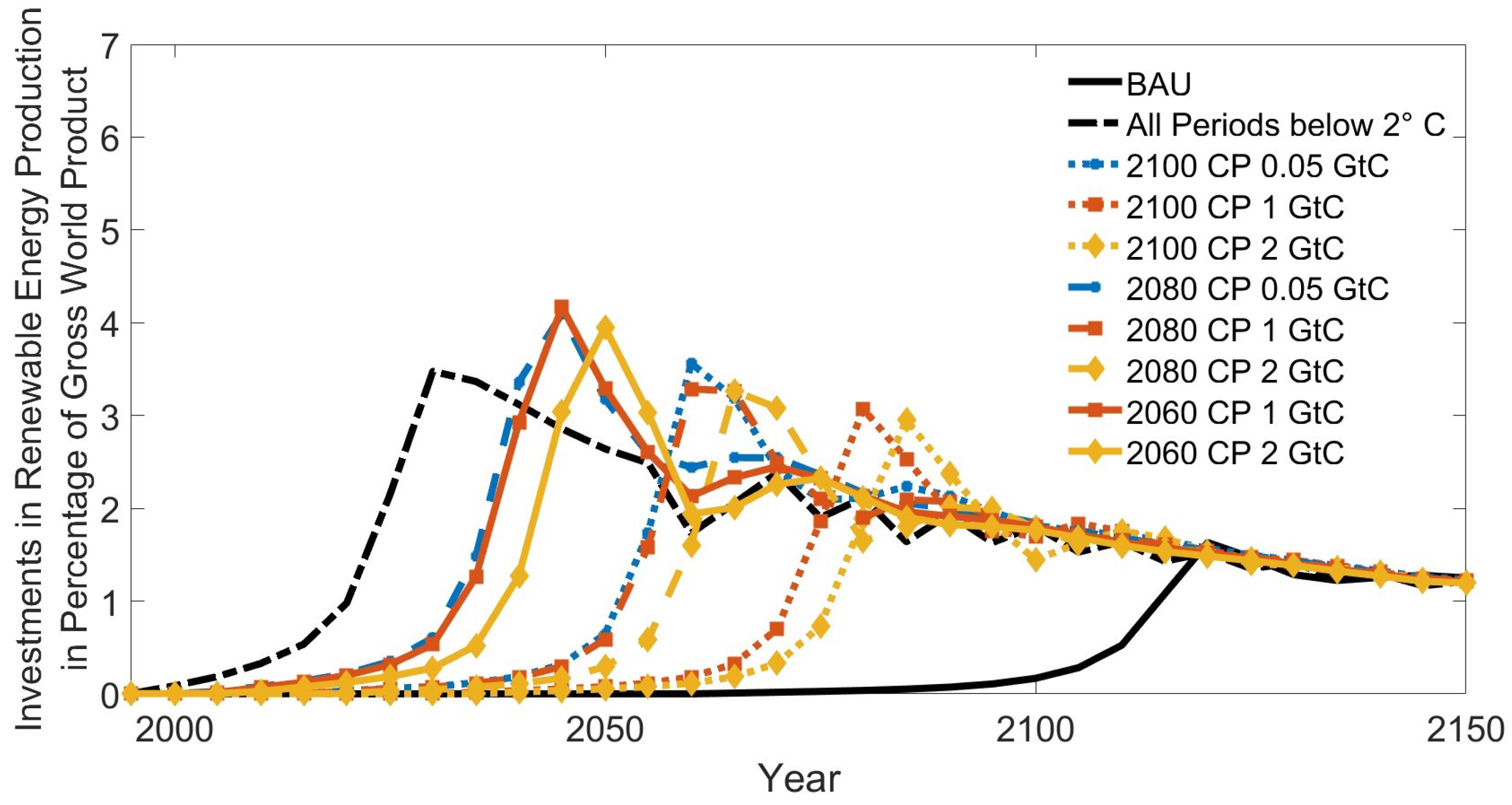
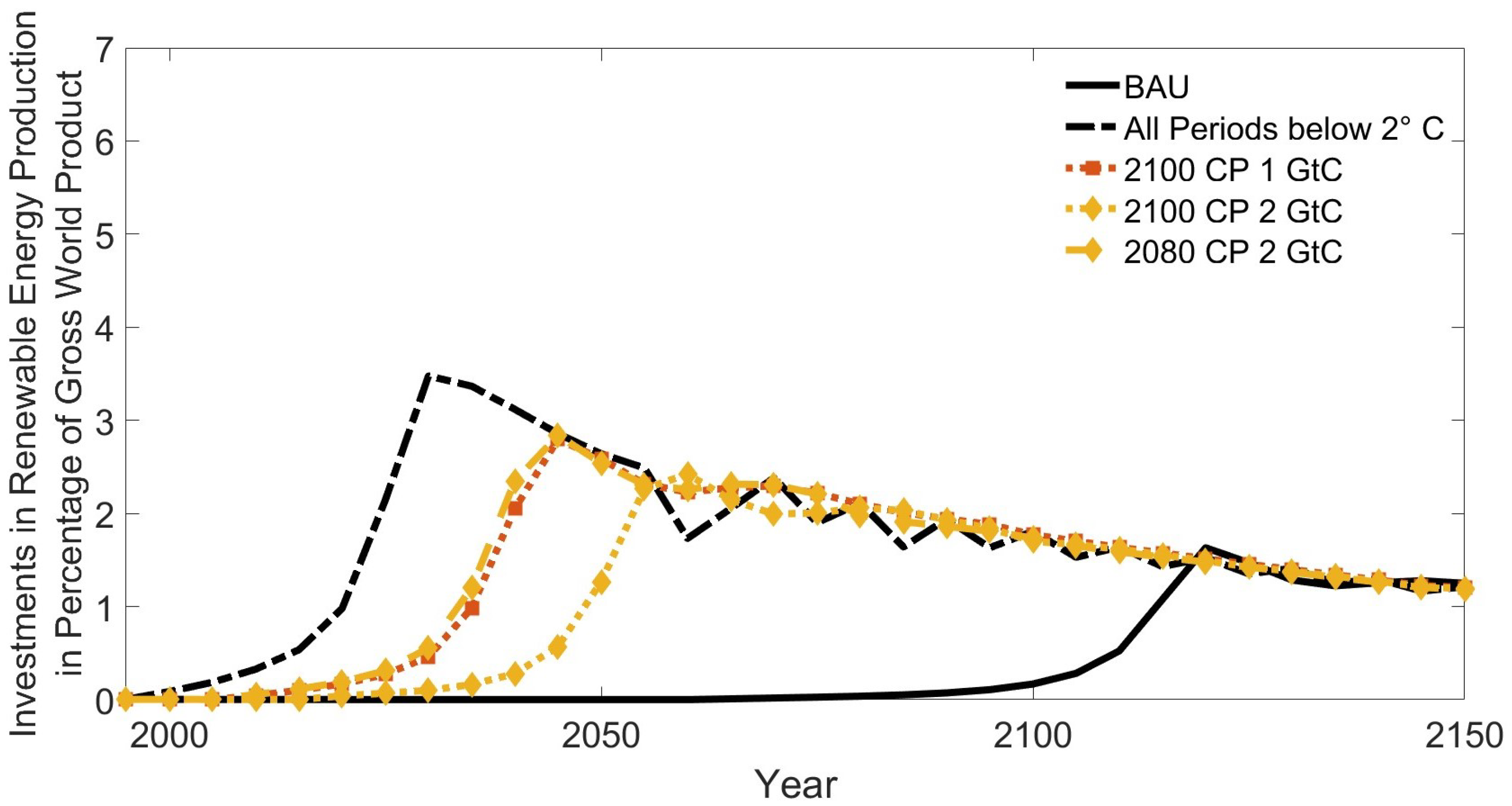
| Climate Policy | Inspired by | Shorthand |
|---|---|---|
| No Change of Climate Policy | Business as Usual | BAU |
| All Periods below 1.5 C | COP 21 | GMT ≤ 1.5 |
| All Periods below 2.0 C | COP 16 | GMT ≤ 2.0 |
| Low Carbon Emissions from 2100 onwards | 41st G7 Summit, June 2015, COP 21 | 2100 CP |
| Low Carbon Emissions from 2080 onwards | COP 21 | 2080 CP |
| Low Carbon Emissions from 2060 onwards | COP 21 | 2060 CP |
| Scenario | Carbon Emission Inertia | Global Mean Temperature Change in 2100 | |||||
|---|---|---|---|---|---|---|---|
| BAU | 12.6% | 3.12 C | |||||
| GMT ≤ 1.5 C | 12.6% | n. d. | |||||
| GMT ≤ 2.0 C | 12.6% | 2.00 C | |||||
| 0.05 GtC | 1 GtC | 2 GtC | |||||
| w/o INDC | INDC | w/o INDC | INDC | w/o INDC | INDC | ||
| 2100 CP | 12.6% | 2.86 C | 2.83 C | 3.26 C | 3.24 C | 3.28 C | 3.26 C |
| 9.0% | 2.45 C | 2.41 C | 3.14 C | 3.12 C | 3.23 C | 3.21 C | |
| 5.3% | n. d. | n. d. | 2.79 C | 2.76 C | 3.03 C | 3.00 C | |
| 3.7% | n. d. | n. d. | 2.43 C | 2.40 C | 2.78 C | 2.75 C | |
| 2080 CP | 12.6% | 2.27 C | 2.24 C | 2.87 C | 2.84 C | 2.99 C | 2.96 C |
| 9.0% | 1.92 C | n. d. | 2.69 C | 2.66 C | 2.88 C | 2.86 C | |
| 5.3% | n. d. | n. d. | 2.33 C | 2.30 C | 2.61 C | 2.58 C | |
| 3.7% | n. d. | n. d. | 2.06 C | n. d. | 2.39 C | 2.36 C | |
| 2060 CP | 12.6% | 1.77 C | n. d. | 2.30 C | 2.27 C | 2.46 C | 2.43 C |
| 9.0% | n. d. | n. d. | 2.17 C | 2.14 C | 2.37 C | 2.34 C | |
| 5.3% | n. d. | n. d. | 1.92 C | n. d. | 2.18 C | n. d. | |
| 3.7% | n. d. | n. d. | n. d. | n. d. | 2.04 C | n. d. | |
| Scenario | Carbon Emission Inertia | Certainty and Balanced Growth Equivalents | |||||
|---|---|---|---|---|---|---|---|
| BAU | 12.6% | Benchmark | |||||
| GMT ≤ 1.5 C | 12.6% | n. d. | |||||
| GMT ≤ 2.0 C | 12.6% | −0.88% | |||||
| 0.05 GtC | 1 GtC | 2 GtC | |||||
| w/o INDC | INDC | w/o INDC | INDC | w/o INDC | INDC | ||
| 2100 CP | 12.6% | −0.24% | −0.26% | −0.08% | −0.09% | −0.06% | −0.07% |
| 9.0% | −0.45% | −0.46% | −0.11% | −0.12% | −0.07% | −0.08% | |
| 5.3% | n. d. | n. d. | −0.22% | −0.24% | −0.12% | −0.14% | |
| 3.7% | n. d. | n. d. | −0.43% | −0.44% | −0.22% | −0.23% | |
| 2080 CP | 12.6% | −0.59% | −0.60% | −0.23% | −0.24% | −0.17% | −0.18% |
| 9.0% | −0.95% | n. d. | −0.29% | −0.30% | −0.20% | −0.21% | |
| 5.3% | n. d. | n. d. | −0.49% | −0.51% | −0.30% | −0.32% | |
| 3.7% | n. d. | n. d. | −0.80% | n. d. | −0.45% | −0.47% | |
| 2060 CP | 12.6% | −1.23% | n. d. | −0.54% | −0.55% | −0.42% | −0.43% |
| 9.0% | n. d. | n. d. | −0.65% | −0.66% | −0.47% | −0.49% | |
| 5.3% | n. d. | n. d. | −0.96% | n. d. | −0.63% | n. d. | |
| 3.7% | n. d. | n. d. | n. d. | n. d. | −0.83% | n. d. | |
Publisher’s Note: MDPI stays neutral with regard to jurisdictional claims in published maps and institutional affiliations. |
© 2022 by the authors. Licensee MDPI, Basel, Switzerland. This article is an open access article distributed under the terms and conditions of the Creative Commons Attribution (CC BY) license (https://creativecommons.org/licenses/by/4.0/).
Share and Cite
Khabbazan, M.M.; Hokamp, S. Decarbonizing the Global Economy—Investigating the Role of Carbon Emission Inertia Using the Integrated Assessment Model MIND. Economies 2022, 10, 186. https://doi.org/10.3390/economies10080186
Khabbazan MM, Hokamp S. Decarbonizing the Global Economy—Investigating the Role of Carbon Emission Inertia Using the Integrated Assessment Model MIND. Economies. 2022; 10(8):186. https://doi.org/10.3390/economies10080186
Chicago/Turabian StyleKhabbazan, Mohammad M., and Sascha Hokamp. 2022. "Decarbonizing the Global Economy—Investigating the Role of Carbon Emission Inertia Using the Integrated Assessment Model MIND" Economies 10, no. 8: 186. https://doi.org/10.3390/economies10080186
APA StyleKhabbazan, M. M., & Hokamp, S. (2022). Decarbonizing the Global Economy—Investigating the Role of Carbon Emission Inertia Using the Integrated Assessment Model MIND. Economies, 10(8), 186. https://doi.org/10.3390/economies10080186






